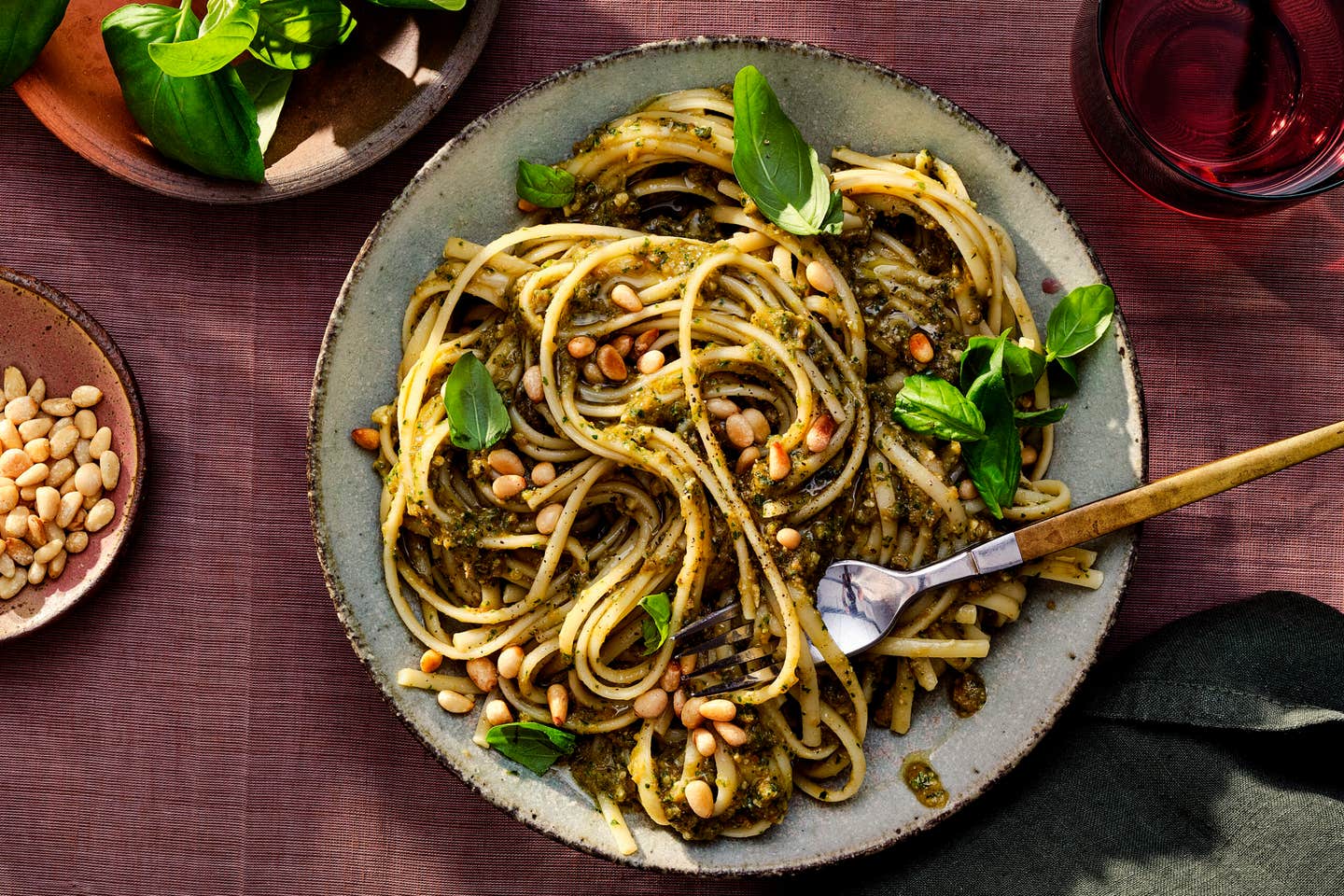How They Make Pesto on a Remote Italian Island
A fragrant blend of almonds, garlic, herbs, and fresh tomatoes makes o’ pistu linusaru the perfect late-summer pasta sauce.
- Serves
4-6
- Time
35 minutes

Rising from the Mediterranean 100 miles from both Sicily and Tunisia, the remote Italian island of Linosa is part of the Pelagie chain, whose name comes from the Greek for “open sea.” Linosa may be a world away from Genova, the city that birthed Italy’s most famous pesto, but it’s home to an equally worthy red pesto brimming with herbs, nuts, garlic, and tomatoes.
Owing to its isolation, Linosa wasn’t settled until the mid-19th century, when a few dozen Sicilian families arrived. They survived by farming lentils on the contours of shallow craters layered with fertile black volcanic soil, and fishing the tumultuous Pelagian waters.
Today, the island’s population hovers around 400, and its economy has changed relatively little. The Linosani still thresh lentils by hand and harvest figs, prickly pears, and tomatoes that wind up in the kitchens of local trattorias serving cucina casalinga (down-home comfort food).
Like all visitors to Linosa, I arrived by sea. After a brisk, bumpy hydrofoil ride from Lampedusa, the closest neighboring island, I landed in a port trimmed with boxy, colorful houses and inviting trattorias. One of these was Trattoria Da Anna. On the blue-tiled veranda, I tried a dish I’d never heard of before—and that I’ve been cooking constantly ever since: o’ pistu linusaru. Pesto traditions vary across Italy, and this local rendition diverged considerably from the internationally famous green Genovese. As the owner explained, it contained fresh tomatoes, pine nuts, almonds, parsley, basil, olive oil, and garlic. Here, it clung to long, perfectly al dente strands of linguini.
Unlike pesto alla genovese (or that of Trapani in Sicily, for that matter), Linosa’s pesto omits cheese, making it akin to pestos I’ve tried in Sardegna. O’ pistu linusaru was a mouthwatering reminder that pesto is basically any pasta sauce that blends—pestare means mash—fragrant local produce and herbs.
A couple of cooking notes: A mortar and pestle is the traditional, low-fi way to blend together the nuts, garlic, and herbs in this recipe, but even the local nonne in Linosa aren’t above the food processor these days—and neither am I. If your tomatoes are particularly juicy and risk rendering the pesto too loose, strain off some of the tomato water (which is marvelous on toast with a drizzle of olive oil).
Ingredients
- 4 medium plum tomatoes (12 oz.)
- 1 cup packed torn fresh basil leaves, plus more for garnish
- ½ cup lightly toasted blanched almonds
- ⅔ cup coarsely chopped parsley leaves
- ¼ cup toasted pine nuts, plus more for garnish (optional)
- 2 tsp. fine sea salt, plus more to taste
- 1 large garlic clove
- 2 Tbsp. extra-virgin olive oil
- 1 lb. linguine
Instructions
Step 1
Step 2
Step 3
- Meanwhile, make the pesto: When the tomatoes are cool enough to handle, peel and quarter them and transfer to a food processor. Add the basil, almonds, parsley, pine nuts, and salt and blend until chunky, about six 1-second pulses. Pour in the olive oil and blend until smooth.
Step 4
- Using a paring knife, cut a small cross in the bottom of each tomato. Bring a large pot of generously salted water to a boil. Add the tomatoes and boil until the skin begins to release, about 30 seconds. Using a slotted spoon, transfer to a cutting board.
- While the tomatoes cool, boil the pasta: To the pot, add the linguine and cook until al dente, 9–14 minutes (pasta cooking times vary widely, so start checking after 8 minutes).
- Meanwhile, make the pesto: When the tomatoes are cool enough to handle, peel and quarter them and transfer to a food processor. Add the basil, almonds, parsley, pine nuts, and salt and blend until chunky, about six 1-second pulses. Pour in the olive oil and blend until smooth.
- Set aside 1 cup of the pasta water, then drain the pasta and return it to the pot. Add the pesto and toss to combine. (If the sauce is too dry, thin it out with pasta water to the desired consistency.) Season with salt to taste, garnish with basil and pine nuts if desired, and serve hot.
Keep Reading
Continue to Next Story










